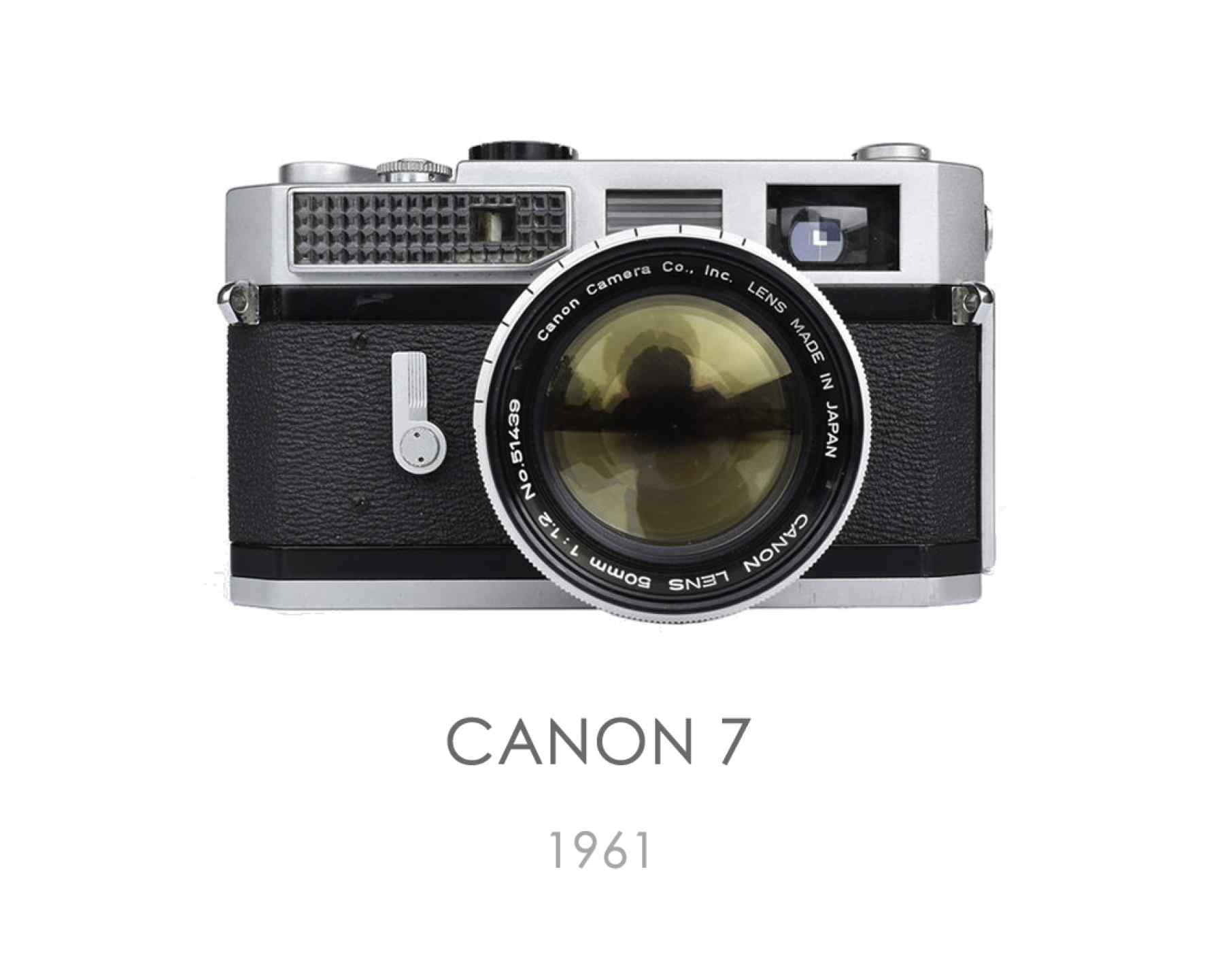The Canon 7 is a 35 mm coupled rangefinder camera made by Canon in 1961: the same year as the Canonet. It followed the Canon VI and Canon P.
It was the first of Canon's rangefinder cameras to have a built-in lightmeter. This is a dual-range selenium meter (the low range is EV 6-13 at ISO 100, and the high range EV 12-19): the range is selected with the small knurled knob beside the finder eyepiece, to show either a black dot (low sensitivity; i.e. high EV) or an orange one (high sensitivity) in the hole above the knob. The meter is coupled to the shutter speed dial, which incorporates the film-speed dial. The meter indicator is a needle pointing to aperture values in the centre of the top plate.
The camera has a focal plane shutter with metal curtains, travelling horizontally. This has speeds 1 - 1/1000 second, plus 'B', 'T' and an 'X' position for flash synchronisation at 1/60 second. The synchronisation is by a PC socket on the left-hand end of the top housing. In order to accommodate the meter in the top housing, there is no built-in flash shoe.
The Canon 7 has a normal 39 mm screw lens mount, and in addition a bayonet mount (bayonet mount 'M') to accommodate the 50 mm f/0.95 lens made specially for this camera. (No other lens is known to have been made for this mount.)
The viewfinder has brightline frames for 35, 50, 85 and 135 mm lenses; one of these is selected with a dial on the top plate. The finder has automatic parallax correction.
Film advance is by a lever, and there is a frame counter, which resets automatically when the back is opened. Rewind is by a folding crank; the film is released for rewinding in the 'R' position of the collar round the shutter release button. The back opens with a catch on the left hand end, but there is also a lock on the bottom of the camera.
There is a self-timer on the front of the body.
The camera was made in silver and, much less commonly, black finish.
The Canon 7 has no accessory shoe, despite the need for one for any lens wider than 35 mm. The solution is an "accessory coupler", specific to this model. The coupler attaches to the bayonet flash socket to the left of the camera (as held for use), and itself has an external bayonet flash socket. It brings the accessory shoe over the centre of the camera. Users (or collectors) of this camera outside Japan tend to complain about the rarity and price of the accessory coupler but it is easily found in Japan.
137,250 examples of the Canon 7 were manufactured, far more than any other model: 87,875 of the "popular" model Canon P were made, and only 20,000 or so of the Canon 7s (the successor to the Canon 7) were manufactured.
| Name: | Canon 7 |
| Manufacturer: | Canon Japan |
| Made in: | Japan |
| N°: | 855569 |
| Production Date: | |
| Type: | 35mm focal-plane shutter rangerfinder camera |
| Series: | Rangefinders |
| Picture Size: | 24 x 36 mm |
| Normal Lens: | Canon 50mm f/0.95 and others |
| Lens Mount: | M39 mount |
| Focus: | Manual Focus |
| Shutter: | Two-axis, horizontal-travel focal-plane shutter with metal curtains. Single-axis non-rotating dial for X, T, B, 1, 1/2, 1/4, 1/8, 1/15, 1/30, 1/60, 1/125, 1/250, 1/500, and 1/1000 sec. Equipped with built-in self-timer and shutter button lock. |
| Dimensions & Weight: | 140 x 81 x 31 mm, 865 g (with 50mm f/0.95) |
| Production Period: | June 1961 - November 1964 |
| N° Produced: | 137.250 |
| Original Price: | 47,500 yen (w/50mm f/1.4) |
| Indexed Price (Approx.): | |
| Avg Ebay Value: |
